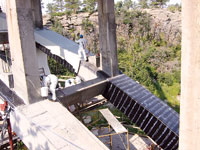 |
| New Stresses. FHWA program encourages more use of prestressed, post-tensioned concrete paving. (Photo courtesy of FHWA) |
Back in the 1990s, recalls Heath Carr, president of Fibrwrap Construction Inc., “everyone would look at you like you were crazy” for proposing to repair a bridge with composite fiber components. But 5,000 retrofits later, the looks are gone. Although fiber reinforced polymers (FRPs) still are not in the mainstream of transportation construction, they are far from esoteric. Carr notes that “the costs of traditional steel and concrete costs have inflated, whereas FRP costs have stayed the same.”
But many bridge and highway engineers say mainstream use of FRP still is in its infancy. “If the high costs of steel don’t come down, we will see more FRP,” says Ray McCabe, New York City-based bridge and tunnel chairman for HNTB Corp. On the other hand, steel costs are moderating and costs of other materials also have risen, says Conn Abnee, executive director of the National Steel Bridge Alliance, Chicago.
The overall effect of higher material costs is that owners and engineers must repair and build highway infrastructure with the hopes of reducing life-cycle costs. That means using higher-strength or longer-lasting materials and increased quality assurance no matter what materials are used. That is why technician certification programs, first mandated by the Federal Highway Administration 10 years ago, are being updated for the second time by regional public-private collaborative certification groups.
|
“Applications of quality assurance are more formal now than they have ever been,” says Bob Christman, director of pavement engineering for Vanasse Hangen Brustlin Inc., Watertown, Mass. Christman works with the New England Technician Certification Program, Marshfield, Mass., which certifies on materials specs for New England states. “We have developed training courses on hot mix, soils, portland cement, and new areas,” he says.
The program emphasizes contractor responsibility for quality of materials, including independent quality assurance, lab credentials for suppliers and other formal assurances. “The contractor is fully responsible for all production and placement processes,” says Christman. “With these specs in place, you can’t help but get longer-lasting pavement.”
The emphasis on contractor responsibility is echoed by Jon Epps, engineering services manager for Granite Construction Inc., Watsonville, Calif. “We need relationships between material properties and performance-based specs,” he states. “As the prime contractor, you must supply the quality-control component to the subcontractors.”
With the increased responsibility comes increased opportunity for innovation and incentives for contractors, notes Christman. And FHWA’s newly created Highways for Life program will contain $75 million of incentive money through 2009 when the application regulations for grants are issued in spring. FHWA is eager to speed up transfer of knowledge gleaned both from other countries and from research departments through HfL, says Richard Capka, acting FHWA chief. “We’re looking for lab-emerging technologies and a lot of overseas opportunities,” he says, noting that Japan, for example, has pioneered use of self-consolidating concrete.
In the U.S., “the speed at which changes are coming is rapid,” says Chris Baker, senior project manager with VHB. For example, the American Association of State Highway and Transportation Officials recently allowed for 15,000-lb-per-sq-in. concrete in its codes, and states are quickly accepting 75-kips-per-sq-in. steel. And a revised design guide reflecting advances in concrete and asphalt road paving is in the works—possibly as soon as this year. “It’s a much more sophisticated guide than the past. It’s actually a software program,” says Leif G. Wathne, national director of highways for the American Concrete Pavement Association, Skokie, Ill. “It includes mechanistic characteristics and empirical models. The guide will contain more than the historical performance data of the past. The mechanistic reaction of the materials to stress has been calculated and will allow for much more accurate designs and predictions of performance.”
 |
|
Research. Pennsylvania has been testing corrugated steel web girders. (Photo courtesy of NSBA) |
The collapse of an 80-ft-long, 80-ton concrete section of an I-70 overpass in Pennsylvania triggered a statewide inspection and stoked the rivalry between advocates of steel and concrete for highway bridges (ENR 2/6 p. 9). The latter hope that increased use of high-performance concrete (HPC) will prevent similar situations.
HPC has been around for 15 years, and is expected to allow infrastructure to last 75 to 100 years rather than 50 years. “It’s not being used much for bridges because it’s a matter of inertia on the part of state highway departments to change their specifications and adopt new methods and procedures,” says Dave Bilow, director of engineered structures for the Portland Cement Association, Skokie.
Concrete Connection
But the new federal emphasis on innovation and bridges with 75-year lives will make HPC a major player, says VHB’s Baker. And other new concrete technologies for both bridges and pavement are coming. For example, Bilfinger Berger Civil Inc., Vancouver, Wash., hopes to introduce a two-paver European concrete laydown technique to the U.S., says President Pat Stricklin. The first, less-expensive layer is paved with a machine that also features the dowel bar inserter. The higher-quality top layer is placed with a conveyor belt that runs over the first paver.
The California Dept. of Transportation turned to Germany-based Degussa Admixtures Inc. for faster-setting concrete. A mixture of portland cement, a stabilizer, superplasticizers and non-chloride accelerator is producing a concrete pavement ready to be used in four hours, rather than 10 days. The procedure is called 4x4 Concrete because it achieves performance levels of 400-psi flexural strength within four hours after placement. “This has worked very well at airports and high traffic areas,” says Jim Anderson, western engineering manager for Degussa.
Anderson cautions that the process can cost more than traditional concrete, but “it is very valuable in instances where liquidated damages to the contractor are $1,000 a minute for delays in opening.”
Self-consolidating concrete (SCC) also is gaining in popularity. “In the last few years, it has been widely accepted by the bridge community, especially the precast- prestress community,” says Bilow. Produced by a high-range water-reducing admixture or a viscosity-modifying admixture, SCC can cut labor costs by 33%. “We will see more use of it,” predicts McCabe.
Other pending developments include ultrahigh-performance concrete, or reactive-powder concrete, being tested at the Turner Fairbanks lab outside Washington, D.C. Strength can reach 30,000 psi, compared to 6,000 psi for conventional concrete. FHWA is testing precast prestressed concrete girders made of this material on a bridge in Iowa. Several bridges in France have already been built with it and have 100-year life expectancies.
Prestressed, post-tensioned concrete is proving useful in an age of building highways with minimal disruption. In Oregon, bulb-T girders made by Harrisburg, Ore.-based Morse Bros. Prestressed Concrete Group reached 183 ft long—a U.S. record. Erected late last year for a U.S. 97 bridge over a railroad, the girders did away with extensive falsework and temporary platforms.
 |
 |
|
Concrete Advances. Precast, prestressed bulb T girders made by Morse Bros. Prestressed Concrete Group in Oregon reached lengths of 183 ft, the longest ever in the U.S. (Photos courtesy of Morse Brothers) |
Asphalt Advances
“Perpetual pavement” is the name of the game for the asphalt industry. Dave Newcomb, vice president for research and technology with the National Asphalt Pavement Association, Lanham, Md., says perpetual pavements are designed to last indefinitely—with the caveat that they must be designed so that any problems arise on the surface and can be ground off and replaced.
Mainstream use of perpetual pavement depends on completion of the revised mechanistic design guide. Once implemented, “the use of the mechanistic process to design according to load effects will greatly increase efficiency,” says Newcomb.
Other major developments include stone-matrix asphalt, warm-mix asphalt, and porous pavement, where water flows straight through the pavement and is absorbed into the ground. In warm-mix asphalt, cooler temperatures help reduce emissions by reducing vapor levels. Crews can work longer hours with warm-mix than with hot-mix because of the reduced heat and fumes.
Long-term evaluations still are needed. “I think it could be the next big thing, but there are some questions regarding cost and durability that need to be answered,” concedes Newcomb.
The emphasis by FHWA and states on accelerated rehabilitation and construction is music to the ears of the National Steel Bridge Alliance. With prefabrication of large superstructure sections, “we can be a major player” in meeting that goal, says NSBA’s Abnee. Prefabricated steel bridge sections are lighter than concrete counterparts, handle the same or more loads, and can be placed quickly, he says.
Prefabricated steel bridge decks have been rare to date, but “will become a common practice,” predicts Abnee. “Sandwich” decks consisting of steel plates with a filler of polyurethane or other material provides the same strength and rigidity of a concrete deck but are lighter and more quickly applied, says Abnee. “Some of these are in the demonstration phase.”
A recent demonstration project in Nebraska showcases the first steel bridge that makes extensive use of 100-ksi steel (75-ksi is the current standard). The two-span 139-ft-long bridge crosses I-80. Designers substituted 100-ksi HPS for all webs and flanges to demonstrate that fabrication and construction could proceed normally. Use of HPS allowed designers to increase the span length of each girder beyond the traditional 120 ft, while keeping the total weight of each girder below 30-ton crane capacity.
Pennsylvania Dept. of Transportation, with Lehigh University and Drexel University, is testing corrugated web girders and tubular flanges on bridges. Corrugated girders, featuring regularly spaced depressions and ridges, are lighter than conventional girders and require only bearing stiffeners, but may require a significant investment in equipment, notes Richard Sause, director of Advanced Technology for Large Structural Systems (ATLSS) Center at Lehigh University.
Steeled
PennDOT will test 60-ft-long tube-shaped flanges on girders as soon as 2007. The concrete-filled tubular flange should provides more strength, stiffness and stability than a flat-plate flange, says Sause.
Future research will focus on creating steel with the corrosion-resistant capabilities of stainless steel yet at lower cost,” says Abnee. NSBA also hopes to produce a 100-year paint coating product in the next four years.
 |  |
 |  |
| FRP Repairs. Carbon-fiber column wraps for deteriorated bridges keep supplier busy. (Photos courtesy of Fibrwrap) | |
Fibrwrap’s Carr says FRP fiber column wraps, bearings, beams and other elements provide advantages in weight, durability and weather-resistance, but he concedes that “FRP does not solve every problem.” Researchers have been looking at large full-scale bridges of FRP for almost 20 years, but they’re still 10 years down the road, he says (ENR 7/1/96, p. 32).
 |
| Perpetual. Engineers constantly are testing new mixes and methods for longer-lasting roads. (Photo courtesy of NAPA) |
FRP guidelines are in the works. “The American Society of Civil Engineers is trying to do design manuals on composites,” says Ayman Mosallam, civil engineering professor at the University of California, Irvine. “The major thing is education. We don’t want people to shy away from the materials because they think it’s complex. You have to treat it like anything else we do and use engineering sense.”
Availability of FRP materials is an issue. “When you let a contract, if you say, ‘use plastic rebar’ and the supplier tells the contractor it’ll be a 27-week delivery time,” that’s an issue, notes VHB’s Baker. “Owners will have to find projects to draw in use of FRP materials.”
The lure of FRP’s durability is that “the baby boomer bridges in this country are getting old,” Baker notes. “And you just cannot repair a bridge only to shut it down again in 20 years.”

Post a comment to this article
Report Abusive Comment